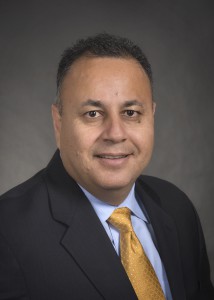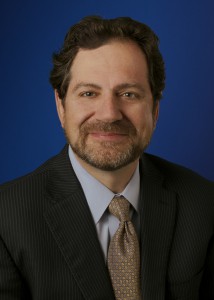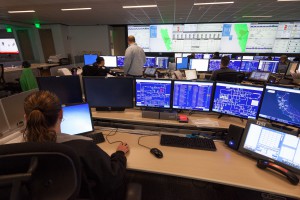April 2014, Vol. 241 No. 4
Features
Life In A Fish Bowl: Two Industry Veterans Work To Rebuild PG&Es Gas Operations

The wall of windows in Nick Stavropoulos’ 32nd-floor office near the Embarcadero in San Francisco can produce some panoramic views. It’s a perspective befitting a 30-year-plus industry veteran whose career parallels the emergence of the modern natural gas pipeline industry, making him one of the leaders in shaping these advances.
The serene executive office setting is a bit misleading, however, as down on the ground Stavropoulos’ life has been anything but calm. He has encountered almost continuing turmoil in the two years he has headed Pacific Gas and Electric Co.’s (PG&E) gas operations as executive vice president.
Along with a fellow industry veteran he recruited from Kinder Morgan’s El Paso Pipeline, Jesus Soto, Stavropoulos is overseeing one of the biggest pipeline testing, enhancement and replacement efforts in the industry’s history. He is in the midst of spending an added $4 billion, with much of it being debated by state regulators in terms of its effectiveness and cost, to rebuild the infrastructure, the system’s integrity and the work force culture at PG&E.

On the particular day that Soto and his boss sat down to talk with P&GJ reverberations were still being felt throughout the massive PG&E headquarters from state regulators’ actions that were highly critical of the utility’s ongoing gas operations and, although not naming them, of the two executives heading up the gas system. The accusations had to sting, even for these two thick-skinned veterans.

Stavropoulos expressed open disappointment that officials at the California Public Utilities Commission (CPUC) could be so overwhelmingly critical in light of the work he thinks has been done “to radically” change the safety culture within his organization. Along with all the physical upgrades to 6,750 miles of high-pressure transmission pipeline in the PG&E system, the issue of critical importance to Stavropoulos is improving the safety culture of the several thousand employees in the PG&E gas organization. He obviously thinks that is being done, but the regulators that oversee PG&E just as obviously in their public utterances in 2013 didn’t believe that was the case.
Stavropoulos’ experience in his second full year with a company that has been the focus of a lot of public ridicule since the fatal pipeline rupture and explosion in San Bruno, CA in September 2010 is an object lesson in how good intentions and working smarter doesn’t always translate into positive perceptions among key stakeholder groups.
Nevertheless, Stavropoulos and Soto say they have the resolve, and they will communicate to anyone willing to listen that they intend to prevail as they have in undergoing massive recordkeeping and testing programs that have exceeded the cost and breadth of anything ever tried in the industry. While the unprecedented enhancement work is tied directly back to the tragic San Bruno incident, the uphill battle to overcome political and regulatory skepticism also ties back to that incident for which the combination utility has accepted all of the blame.
Whether PG&E is able to put the incident behind and move forward toward becoming the safest gas system on the planet is still problematic, but it is something the two veterans have been hired to accomplish and they seem to remain undeterred. Nevertheless, there are still plenty of skeptics and critics who are watching closely the large energy company’s every move.
“We have the potential for a cleaner energy supply, greater energy security and – not least – a stronger economy, with new jobs, a revival of U.S. manufacturing, and healthier trade balances,” Soto told a U.S. Senate committee in mid-2013. He reiterated that 60% of the nation’s pipelines were installed at least 40 years ago and some of that pipe “needs upgrading or replacing; others need more sophisticated inspection and maintenance technologies to ensure that they remain safe.”
The latter part of what Soto told the Senate Committee is where the rubber meets the road every day in his PG&E work overseeing public safety and integrity management; project engineering and design; gas transmission; and gas system operations. Since San Bruno, this has included spending more than $1 billion on hydrostatically testing 633 miles of high consequence area (HCA) transmission pipelines, installing more than 100 automatic remote-controlled valves and countless other leak surveying, digitizing/updating all pipeline records and introducing new technology for all of this work.
As an example, the San Francisco-based multibillion-dollar combination utility last fall began testing a new wireless-controlled 20-foot-long robot to inspect its gas transmission pipelines. The robot uses high-definition cameras, super-sensitive sensors and a laser probe to inspect for dents, cracks or corrosion without having to take the line out of service for inspections.
This coincides with what Soto knows best because during his El Paso career that spanned several decades he served on the executive committee for the Pipeline Research Council International (PRCI). He also was part of a corporate exchange with Wintershall Gas GmbH in Kassel, Germany.
In reflecting on rigid standards and strong public scrutiny under which the company’s gas system now operates, Stavropoulos attributed it to an “amazingly dynamic environment in which the amount and extent of the work we are doing is unprecedented, and we feel bad that we have let [regulators and other] people down, but at no time was there a safety issue involved.”
Soto suggested that skeptics need to look at the dozens of self-reports PG&E has made in recent months and years on problems its own employees uncovered in the gas system. “Look at what we’ve done; it’s a reflection of the culture we are trying to promote and achieve,” he said, offering detail on an incident in San Carlos, CA, a neighboring peninsula suburb to San Bruno south of San Francisco.
A 3.8-mile transmission lateral (Line 147) in 20- and 24-inch segments connects key 36-inch lines (132 and 101)running north-south through the peninsula south of San Francisco where the San Bruno tragedy occurred on a portion of one of the north-south lines (132). Post-San Bruno the maximum allowable operating pressures (MAOP) were lowered on all of these lines, and after hydrostatically testing key segments in 2011, PG&E worked with state regulators to increase the pressures back to something closer to their historic levels (360 ppi).
Work has been almost continuous in the area with three automated valves being installed at a junction of Lines 147 and 101 in San Carlos. Earlier, routine work in late 2012 turned up a leak on the lateral that PG&E repaired and subsequently tested metallurgically, but a year later the utility’s reporting of the situation and changing its recordkeeping on the pipe lateral has resulted in a proposed $17.25 million penalty from one of the state regulators.
Similarly, more recent problems with a contract radiographic weld-testing crew that were discovered and corrected by PG&E drew a citation and multimillion-dollar fine from the state regulatory safety staff.
“We’re not in denial here that we still have problems,” Stavropoulos said. “The frustrating part is that we think the expectation is for us to find and fix the problems. After all, the NTSB [National Transportation Safety Board] and the [California state regulators’] independent review panel reports both concluded that the company had shortcomings around its records, integrity management, and safety culture, and we’re fixing all of those things, and as a result, we’re finding other things, such as the poor workmanship on the radiographic surveying of pipeline welds.”
Despite the setbacks and second-guessing from regulators, he and Soto stressed that they will continue to emphasize the need to “find-and-fix” problems before they become tragedies like San Bruno.
“We tell our employees not to let this [regulatory rebukes and fines] discourage them,” said Soto. “We urge them to continue to bring issues forward because they can’t be addressed unless we know they exist.”
Part of the proactivity that Soto and PG&E are endorsing is embodied in a program announced in 2012 to spend $500 million for a multi-year “restoration” program to obtain the exact centerline location of all 6,750 miles of the utility transmission pipeline system.
Soto said he thinks that incidents like San Bruno and the similar one he experienced with El Paso at Carlsbad, NM (2000) not only change the companies involved, they change the entire industry through revised regulations that results as has happened in the aftermath of both tragedies. El Paso went through dealing with PHMSA, the U.S. Justice Department, and paying a penalty tied to the tragedy, along with adopting a consent decree mandating several remediation programs, Soto recalled vividly.
“Ultimately, it is really about what the company does about it,” he said. “How does the company move forward and address the root issues, the cultural issues, and in my experience with El Paso the board of directors took a very visible role and made a leadership commitment to adopt inline inspection in a very comprehensive way, targeting all of the onshore pipeline system of 6 inches diameter or larger and making it piggable and inspecting it all by the year 2012.
“I was proud to be a very critical component of that [10-year] program, and I have seen how that leads to comprehensive assessments as a key component of managing the risk on an interstate [pipeline] system.”
Soto said one of his missions at PG&E is changing its method of assessment from external corrosion direct assessment (ECDA) to more inline inspection of pipes. That’s a component of PG&E’s four-year, multibillion-dollar pipeline safety enhancement plan (PSEP). “We’re going to make that a more central part of how we address the risk of the PG&E system as we go forward,” he said.
One of the newest and best tools for Soto and PG&E, and a recommendation from federal and state regulators following San Bruno, is the utility’s new state-of-the-art gas control center in San Ramon on the east side of the Oakland Hills about 20 miles across San Francisco Bay from the PG&E headquarters.

“Going with the Flow” At PG&E’s Gas Control Center
Predictive/Proactive
At a 42,000-square-foot gas control center at Bishop Ranch, the staid combination utility is attempting to move from a “monitor and response” operation fostered by the old supervisory control and data acquisition (SCADA)-driven operations to one that is “predictive and proactive,” identifying potential problems before they occur and heading them off.
“We’re moving beyond SCADA, using more tools that allow us to be predictive and proactive,” said 34-year gas utility veteran Keith Slibsager, manager transmission control in PG&E’s gas operations. “That’s exciting for someone like me who remembers when SCADA was first introduced to the utility. We’d take hourly readings walking around the room, reading all the charts, reading the pressures and then sit back down and calculate all the flows. We’d write them on big paper sheets and we’d teletype all the information to San Francisco where our view of the world was recalibrated hourly in tabular display.
“SCADA then took us to real time. We could see almost to the second, and you could get trends, showing you the past four or 48 hours.”
Directly in response to some of the coordination and communications gaps exposed in the hours leading up to the San Bruno incident, the new center brings together separate groups responsible for transmission control, distribution control and gas dispatch. They are all on the fifth floor of the utility’s five-story office complex in San Ramon. Built into the center video walls and high-tech communications capability is the fact that three years earlier when San Bruno erupted the operators were not sure what the information they had was telling them.
“A lot of what we learned from the tragedy we tried to incorporate in this building,” said Slibsager, who was gas control manager on Sept. 9, 2010 when San Bruno’s Line 132 ruptured and exploded. “One lesson was we had gas dispatch split in two locations (Fresno and Concord, CA) and gas control in San Francisco, and what we learned was essentially that there was a lot of activity at each location, but poor coordination among all three.”
As a result, PG&E gas managers traveled around the nation to benchmark other gas operators who had co-located control and dispatch functions. “But it wasn’t enough to get them all together, we also wanted to connect them, and the way we did that was through a series of video walls throughout both sides of the floor,” Slibsager said.The walls are 80 to 90 feet long.
“The video walls achieved the needed connection around the entire floor,” he said. They serve transmission-distribution control functions side-by-side, and dispatch immediately adjacent on the other side of the floor.
When San Bruno occurred, “it wasn’t clear for a while that the pipeline incident was not related to another sort of accident – such as a plane crashing or a nearby gasoline station exploding, so connecting those dots came slowly,” Slibsager remembered, noting the NTSB report recommended more visibility for the transmission pipeline system on the San Francisco peninsula, so PG&E has added numerous remote automatic valves among other devices.
“They also made a recommendation for many more automated valves,” he said, noting it is an extensive ongoing project. Finally, the federal report hit on the need for more comprehensive leak detection. The valve additions allow the control center to shut down smaller portions of the overall system when needed without putting a large area out of service.
The leak detection improvements “are a little further out there,” according to Slibsager. PG&E is working with GL Nobel Denton, the global oil/gas technical service provider, applying some of the consultant’s hydraulic analysis tools.
“We’re prototyping on our transmission system between Hollister, CA and Milpitas, CA,” he said, naming areas both north and south of San Jose. “It is being applied to a 50-70-mile section of pipe to test how effective it can be as a protection system for generating the right responses. So far we’ve seen some pretty favorable results.”
It is essentially a hydraulic model running alongside the SCADA system to look for abnormalities such as a pressure drop beyond the norm, so it could detect a possible leak and/or provide data for planning when there is a need to expand capacity in certain geographic areas.
“It is commonly used in the oil and liquids industries, but it is not as common for natural gas,” said Slibsager, noting that the somewhat expansive control/dispatch function space is designed and built for major emergencies more than day-to-day operations.
Noting that the center takes the real-time temperature of the overall gas system, monitoring the health and operations of all its body parts, Mel Christopher, senior director for PG&E gas system operations, compared the facility to an “air traffic control center, except instead of monitoring flights, takeoffs and landings, [we’re] ensuring that gas is delivered at the proper pressure at all times to meet customer expectations.”
Including a training simulation room that has all the real-time data that gas control operators are using and all sorts of employee-friendly features derived from state-of-art human factors engineering models, the new facility open less than a year makes possible the safety-rich culture that Christopher, Soto and Stavropoulos have been preaching. That shift of mindset includes embracing new technology, and the gas control center embodies that philosophy.
If the business cliché “work in progress” ever had a poster child it would be PG&E’s natural gas system and the men and woman operating it. It resonates in the words of Stravropoulos, Soto, Christopher and Slibsager – all gas industry veterans who know operations can always be improved.
“We have a communications specialist desk – a bridge between transmission/distribution control and gas dispatch – so all the communications, e-paging, and contact with the emergency centers when they are open would come out of this desk for both transmission and distribution,” Slibsager said.
“This is to ensure we are getting out the right messages [internally and externally] and not duplicating resources. It is supposed to help us be very efficient. It is staffed seven days a week on the day shift and on the night shift we can pull a supervisor from dispatch here until we get one of the regulars from on-call.
“That was an addition to the gas control center – beyond the plan.”
Flexibility seems to be the key for this cultural transformation.
Richard Nemec is P&GJ’s West Coast Correspondent. He can be reached at rnemec@ca.rr.com.





Comments